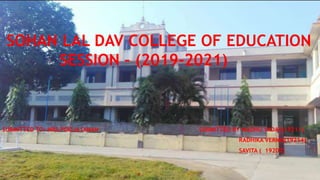
Learning and teaching ppt
- 1. SOHAN LAL DAV COLLEGE OF EDUCATION SESSION – (2019-2021) SUBMITTED TO- MRS.POOJA DIMAN SUBMITTED BY-MADHU YADAV(19211) RADHIKA VERMA(19214) SAVITA ( 19207)
- 2. SCOPE OF PRESENTATION Concept of learning Defination of learning Nature and characteristics of learning Types of learning Factor influencing learning Role of teacher & school in relation to learning strategies.
- 3. CONCEPT OF LEARNING Learning situation are most natural and common in life and everyone of us is learning one thing or the other, although he may not necessarily aware of it. An individual starts learning immediately after his birth. The behavior of an individual is changed through direct or in indirect experiences. This change in behavior brought about by experience is commonly known as learning.
- 4. DEFINATION OF LEARNING Gardener Murphy : “ the term learning covers every modification in behavior to meet environmental requirements.” Gates : “ learning is the modification of behavior through experience.” woodworth : “ any activity can be called learning so far as it develops the individual ( in any respect, good or bad ) and makes his later behavior and experiences different from what they would otherwise have been.” Kingsley and Garry : “ learning is the process by which behavior changed through practice or training.”
- 5. Defination : Learning is… A change in behavior as a result of experience or practice. The acquisition of knowledge. Knowledge gained through study. To gain knowledge of, or skill in, something through study, teaching, instruction or experience. The process of gaining knowledge. A process by which behavior is changed, shaped or controlled. The individual process of constructing understanding based on experience from a wide range of sources.
- 6. Nature and characteristics of learning Learning is the change in behavior. Learning is a continuous life long process. Learning is a universal process. Learning is purposive and goal directed. Learning involves reconstruction of experiences. Learning is the product of activity and environment. Learning is transferable from one situation to another.
- 7. Learning helps in attainment of teaching-learning objectives. Learning helps in the proper growth and development. Learning helps in the balanced development of the personality Learning helps in proper adjustment. Learning helps in the realization of goals of life. Learning does not necessarily imply improvement.
- 8. TYPES OF LEARNING 1. Motor learning Most of our activities in our day to day life refer to motor activities. The individual has to learn them in order to maintain his regular life, for example walking, running, skating, driving, climbing,etc. all these activities involve the muscular coordination.
- 9. 2. Verbal learning : This type of learning involves the language we speak, the communication devices we use. Signs, pictures, symbols, words, figures, sound, etc, are the tools used in such activities. We use words for communication.
- 10. 3. Concept learning : It is the form of learning which requires higher order mental processes like thinking, reasoning, intelligence, etc. we learn different concepts from childhood. For example, when we see a dog and attach the term ‘dog’ , we learn that the word dog refers to a particular animal. Concept learning involves two processes,viz. abstraction and generalization. This learning is very useful in recognizing,identifying things.
- 11. 4. Descrimination learning: Learning to differentiate between stimuli and showing an appropriate response to these stimuli is called discrimination learning. For example sound horns of different vehicles like bus, car, ambulance etc
- 12. 5. Learning of principles: Individual learns certain principles related to science, mathematics, grammar,etc in order to manage their work effectively. These principles always show the relationship between two or more concepts. Example : formulae , laws, associations, correlations, etc.
- 13. 6. Problem solving : This is the higher order learning process. This learning requires the use of cognitive abilities such as thinking, reasoning, observation, imagination, generalization, etc. this is very useful to overcome difficult problems encountered by the people.
- 14. 7. Attitude learning : Attitute is a predisposition which determines and directs our behavior. We develop different attitudes from our childhood about the people, objects and everything we know. Our behavior may be positive or negative depending upon our attitutes. Example: attitudes of nurse towards her profession, patients, etc.
- 15. FACTORS INFLUENCING LEARNING Learner related factor : Learner’s physical and mental health The basic potential of the learner The level of aspiration and achievement motivation Goal of life Readiness and will power
- 16. Teacher related factor : mastery over the subject matter Art and skill teaching Personality traits and behavior of the teacher Level of adjustment and mental health of the teacher Type of discipline and interaction maintained by the teacher.
- 17. Contents related factor : Nature of the contents or learning experience. Selection of the content or learning experiences Organisation of the contents or learning experience.
- 18. ROLE OF TEACHER The teacher ensures humanistic approach and make the learners have intrinsic motivation . There is interaction of all. Team goals and team success are kept in view. All this is allowed to happen so that leadership qualities are imbibed by the students.
- 19. ROLE OF SCHOOL The school provides proper environment for the learning of teaching -learning programme. Conducive environment is the ensured by the school authorities so as to Infuse Social Skill in the students. And above all the school provides flexible type of time table so that the teacher and the students may work with Freedom and achieve the desired goals.